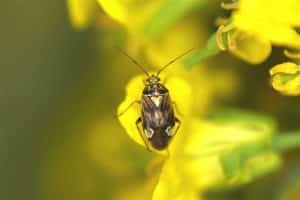
You may be sick of reading about it, but that’s better than being sick of finding it. Lygus bug continues to be a hot topic for growers in a number of locations across the prairies. While numbers are surprisingly high, they may still not be high enough to warrant the cost of spraying. Don’t let the idea of revenge influence your spraying decision-making process. When you are making lygus population management decisions, be sure to consider that current thresholds are under review, and thought to be far too low. Read the latest article on lygus thresholds.
Also, with swathing just around the corner, be sure to check PHIs for insecticides before you spray. The shortest pre-harvest interval (spraying to swathing or spraying to direct combining) for an insecticide that kills lygus is a full seven days. Calculate PHIs and mark your swath date in your calendar by using spraytoswath.ca.
This time of year the lygus bugs you may be finding are likely all adults with oval bodies about 3 mm wide and 6 mm long and long antennae and legs. They can vary in colour from pale green to golden brown or reddish brown to black with a characteristic X on their backs (the top part of which is an obvious v-shaped marking on their upper back). They have sucking mouthparts, so they like to go to the juicy, green, new growth as a nutrient source.
As your canola fields mature from the bottom up, the lower pods begin to dry out and have more of a leathery texture which is harder for the insects to puncture/pierce and suck from. The succulent, green, less mature pods at the top of the plant entice the little critters to move up, where they will be more visible to people checking. Be sure to judge the plant by more than just the number of bugs you see at the top AND by more than just the plants at the edge of the field. Carry out sweep-net monitoring under fair, calm weather conditions, avoiding the peak temperatures of the day.
While the feeding at the top pods won’t cause the final yield to diminish as much as feeding on the more mature bottom pods, lygus may still cause some downgrading by both puncturing and secreting enzymes on seeds, as part of their regular feeding habits.
Another tip to watch for is hail damage, which can make the crop appear more infested than it really is. Sometimes hail will crack the pods, leaving an opening in the tissue, or, as some disease would see it- an opportunity. If a disease enters a pod, it can cause issues such as damaged pods or even mushy seeds. While you may see lygus feeding on portions of hail damaged plants, it is important to distinguish the impacts of the disease from those of the slurping insects.
If you are thinking it may be too late spray for lygus, you may be right. This late in the season, it is absolutely crucial that you check the pre-harvest interval of the insecticide that you will be using. Check out spraytoswath.ca to decide for sure.
